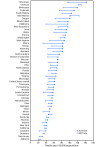Deaths from Falls Among Persons Aged ≥65 Years - United States, 2007-2016
- PMID: 29746456
- PMCID: PMC5944976
- DOI: 10.15585/mmwr.mm6718a1
Deaths from Falls Among Persons Aged ≥65 Years - United States, 2007-2016
Abstract
Deaths from unintentional injuries are the seventh leading cause of death among older adults (1), and falls account for the largest percentage of those deaths. Approximately one in four U.S. residents aged ≥65 years (older adults) report falling each year (2), and fall-related emergency department visits are estimated at approximately 3 million per year.* In 2016, a total of 29,668 U.S. residents aged ≥65 years died as the result of a fall (age-adjusted rate† = 61.6 per 100,000), compared with 18,334 deaths (47.0) in 2007. To evaluate this increase, CDC produced age-adjusted rates and trends for deaths from falls among persons aged ≥65 years, by selected characteristics (sex, age group, race/ethnicity, and urban/rural status) and state from 2007 to 2016. The rate of deaths from falls increased in the United States by an average of 3.0% per year during 2007-2016, and the rate increased in 30 states and the District of Columbia (DC) during that period. In eight states, the rate of deaths from falls increased for a portion of the study period. The rate increased in almost every demographic category included in the analysis, with the largest increase per year among persons aged ≥85 years. Health care providers should be aware that deaths from falls are increasing nationally among older adults but that falls are preventable. Falls and fall prevention should be discussed during annual wellness visits, when health care providers can assess fall risk, educate patients about falls, and select appropriate interventions.
Conflict of interest statement
No conflicts of interest were reported.
Figures


References
-
- National Center for Health Statistics. Health, United States, 2016: with chartbook on long-term trends in health. Hyattsville, MD: US Department of Health and Human Services, CDC, National Center for Health Statistics; 2017. - PubMed
MeSH terms
LinkOut - more resources
Full Text Sources
Other Literature Sources
Medical

